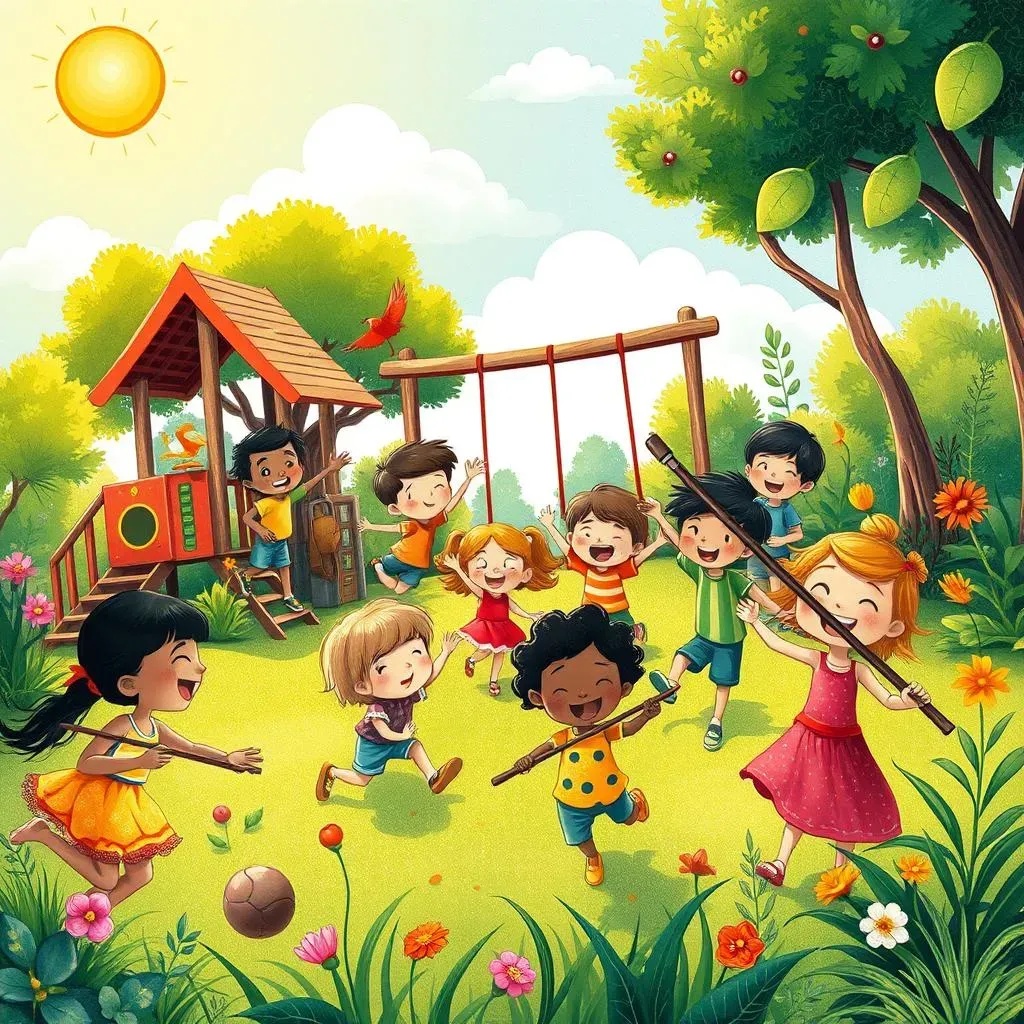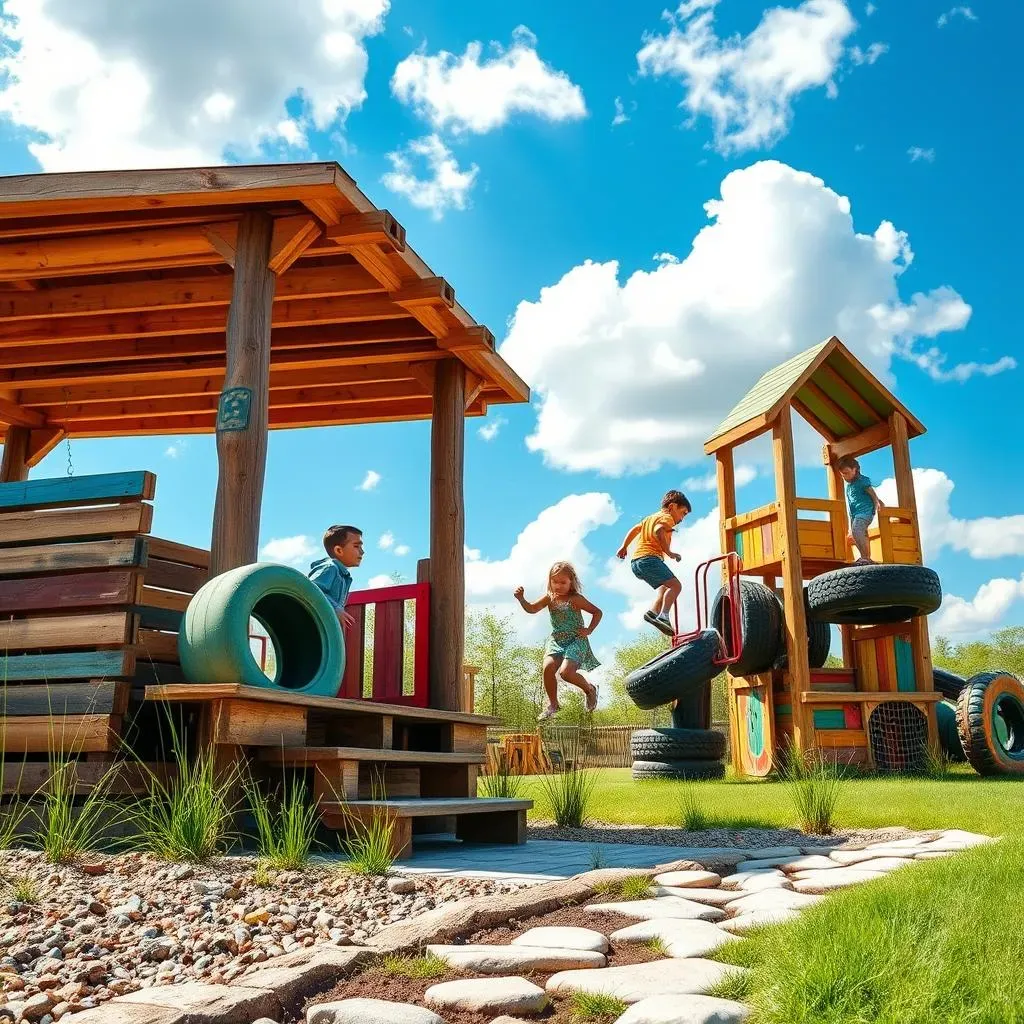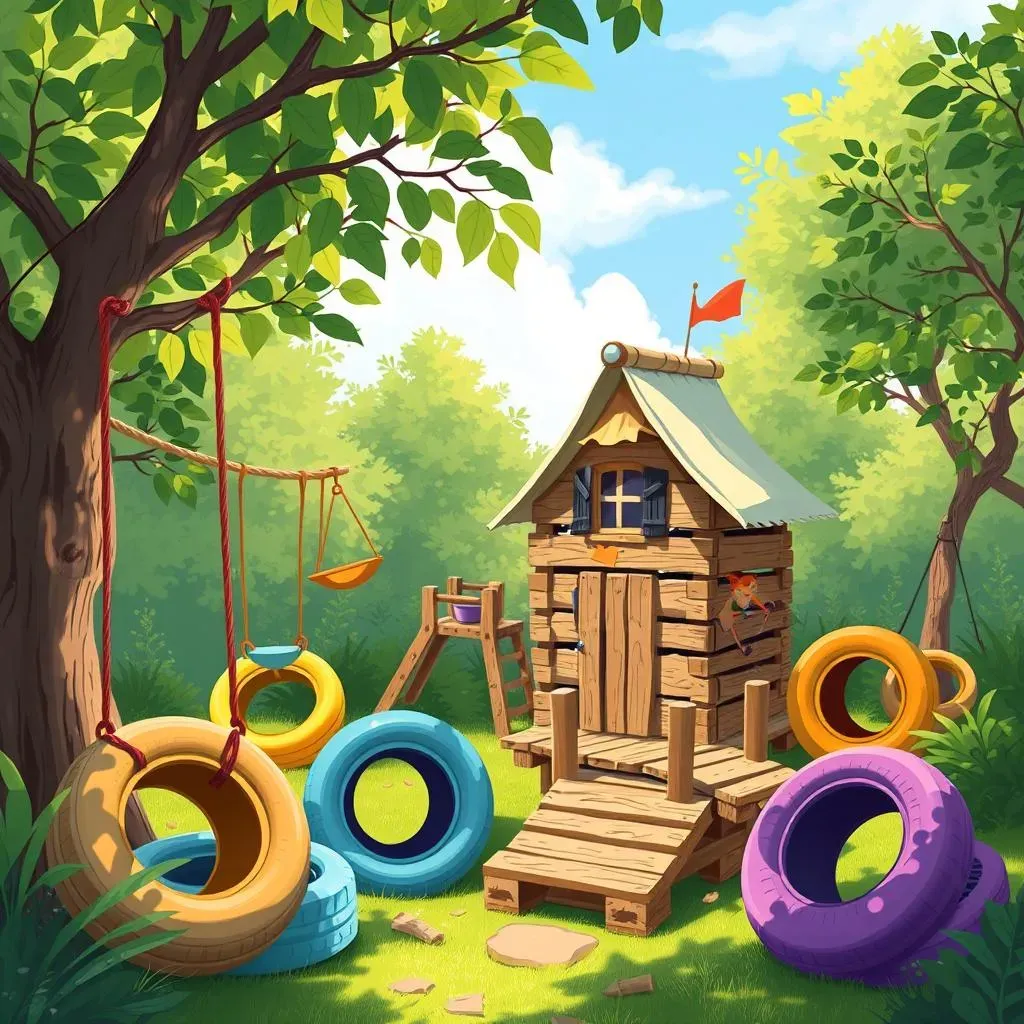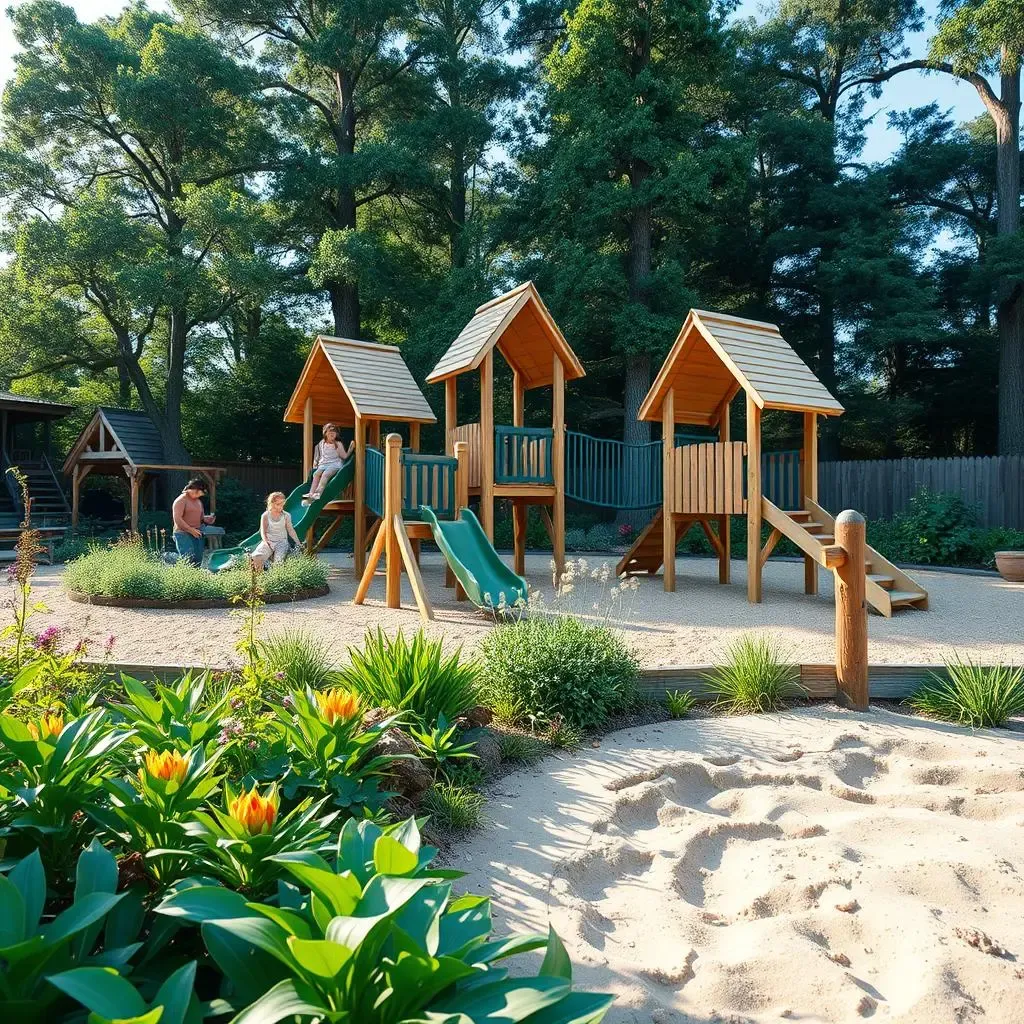Table of Contents
Ever dream of a backyard wonderland where kids can laugh, play, and connect with nature? What if you could build it yourself, using materials that are kind to the planet? That's the magic of DIY eco-friendly playground equipment! This isn't just about building a swing set; it's about creating a space where imagination thrives and little ones learn to love the Earth. We're not talking about complicated construction projects either. Think more along the lines of clever upcycling and using natural elements to craft fun and engaging play areas. In this guide, we’ll walk you through how to plan your own eco-friendly playground, focusing on sustainable design principles and showing you how to make your own equipment. We’ll explore how to choose materials that are good for the Earth, and how to create a space that supports local wildlife. You’ll also discover how to keep your playground in top shape and how to use it as a way to teach kids about nature. So, if you're ready to transform your outdoor space into an eco-friendly adventure zone, let’s get started on this DIY journey!
Planning Your EcoFriendly Playground

Planning Your EcoFriendly Playground
Setting Your Goals
Okay, so you're ready to build an awesome, eco-friendly playground, that's fantastic! But before you grab a shovel, let's talk about what you actually want to achieve. Are you dreaming of a space that gets kids moving, or a spot where they can learn about nature, or maybe a bit of both? Think about the age range of the kids who'll be using the area. A toddler's playground will look very different from one for older children. What are the main things you want them to experience? Do you want climbing structures, a sandpit, or a quiet area for reading? Defining your goals early on will make the whole process way easier. It’s like having a map before you go on an adventure; you're less likely to get lost!
This is also a great time to think about any specific needs of the children using the playground. Do you need to make sure the area is accessible for everyone? Are there any safety considerations you need to keep in mind? Thinking about these things now will help you create a playground that's safe and fun for everyone.
Choosing Your Space
Next up, let's look at where your playground will actually go. The space you choose will have a big impact on what you can build. Is it a sunny spot, or is it shady? Is the ground flat or uneven? Take a good look at your yard and really think about how kids will play there. Consider the natural features already there. A gentle slope could be perfect for a slide, while a big tree could become the center of a climbing area. We are looking at making the best use of what you already have and make it even more fun!
Consideration | Why It Matters |
|---|---|
Sunlight | Affects plant growth and comfort |
Ground Level | Impacts the type of equipment |
Natural Features | Can be used to enhance the play experience |
Brainstorming Ideas
Now, for the fun part – dreaming up what your playground will look like! Let's brainstorm some ideas for your DIY eco-friendly playground equipment. How about a climbing structure made from fallen logs? Or a tire swing hanging from a sturdy tree branch? Maybe you could create a mud kitchen using old pots and pans. The possibilities are endless! Don't be afraid to get creative and use your imagination. Think about the materials you have available and how you can use them in new and exciting ways. Remember, this is about making a space that is both fun and kind to the Earth.
Get the kids involved in this part of the planning process. Ask them what they'd like to see in the playground, you might be surprised by their ideas and you know that they will use the playground. They'll also be more invested in the project if they feel like they've been a part of it from the beginning. It’s all about having fun together!
Sustainable Design for Play: DIY Style

Sustainable Design for Play: DIY Style
Choosing Eco-Friendly Materials
Okay, so you've got your playground planned, now it's time to think about what you're going to build it with. This is where the "eco-friendly" part really kicks in. Instead of heading straight for the hardware store, let's look around and see what we can reuse or repurpose. Old tires make fantastic climbing structures or swings, and wooden pallets can be transformed into all sorts of things, from platforms to walls. Think about using natural materials too, like branches, stones, and sand. Not only are these materials better for the environment, but they also add a natural feel to your playground. It's like bringing a little bit of the forest right into your backyard!
When you do need to buy new materials, choose wisely. Look for sustainably sourced wood, like FSC-certified timber, and avoid plastics where possible. There are also some great options for recycled materials, like recycled rubber mulch for soft landings. Choosing eco-friendly materials is about making smart choices that will help protect the planet, while also making a fun and safe place for kids to play.
Upcycling and Repurposing
The best way to make your playground eco-friendly is by upcycling and repurposing items that you already have or can find easily. Think about how you can give old items a new lease on life. That old blanket could become a cozy reading nook, or those plastic bottles can be turned into a fun water wall. You can use old ropes for climbing nets, or even use broken ceramic pots to create a mosaic path. It's amazing how many things you can find around your home or in your community that can be transformed into something fun and useful for the playground.
Upcycling isn't just good for the environment; it's also a great way to save money and get creative. It challenges you to think outside the box and come up with new and inventive ways to use everyday items. Plus, it's a fun project to do with the kids, teaching them the value of reusing and recycling. It's all about turning trash into treasure, and making your playground unique and special.
“The greatest threat to our planet is the belief that someone else will save it.”
- Robert Swan
Designing for Nature
When you are designing your playground, think about how you can incorporate natural elements to make it more engaging and fun. Instead of just building structures, why not create a space that works with nature? Consider using plants to create a natural barrier, or build a small pond for kids to explore. You can also create a sensory path with different textures, like smooth stones, soft grass, and rough bark. The more you can integrate nature into your playground, the more inviting and engaging it will be for children. It's about making the playground a natural extension of the outdoor world.
Think about how you can use the natural elements to enhance play. A large rock could become a climbing challenge, or a patch of wildflowers could be a place for kids to look for bugs. By working with nature, you're not only creating a more sustainable playground, but you're also creating a space that encourages kids to connect with the natural world. It's about making the playground a place where kids can learn, explore, and grow.
Material | Possible Use |
|---|---|
Old Tires | Climbing structures, swings, planters |
Wooden Pallets | Platforms, walls, playhouses |
Branches | Climbing frames, teepees, borders |
Stones | Pathways, borders, stacking games |
Old Blankets | Reading nooks, cozy spots, tents |
DIY EcoFriendly Playground Equipment Ideas

DIY EcoFriendly Playground Equipment Ideas
Tire Swings and Climbers
Alright, let's get into the fun stuff – actually building some cool stuff! One of the easiest and most fun things you can make is a tire swing. Grab an old tire (check with local tire shops, they're usually happy to get rid of them!), and make sure it's clean. You can hang it from a sturdy tree branch using strong rope or chain. If you're feeling adventurous, you can even paint the tire in bright colors or add some fun designs. Another idea? Stack several tires to create a climbing structure. You can secure them with bolts or even just bury them partially in the ground for a stable base. It’s a simple way to add some vertical fun to your playground. Kids love climbing, and these tire structures are a great way to get them moving and using their muscles.
Don't just think about single tires though. How about a tire tunnel? You can line up several tires in a row to create a fun crawling space. Or how about creating a tire obstacle course? Place them in different positions, some standing upright and some laying down, to create a challenging course for kids to navigate. The best part about using tires? They’re super durable, and they can withstand all kinds of weather. Plus, they give old tires a new purpose, which is great for the environment.
Pallet Playhouses and Platforms
Another amazing material for DIY playground equipment is wooden pallets. You know, the kind that stores use for shipping. These are surprisingly versatile! You can stack them to create a simple playhouse or a platform for kids to climb on. Just make sure you sand them down to remove any splinters, and you secure them together with screws or brackets. You can also add a roof with some tarpaulin or fabric to create a cozy hideaway. Pallet playhouses can become a magical space for kids to use their imagination, whether they are playing house, acting out a story, or just hanging out with their friends.
Want to add some more fun to your pallet structure? Why not create a climbing wall? Attach some wooden blocks or rope to the pallet to create handholds and footholds. Or how about creating a pallet bridge? Place a few pallets side by side to create a walkway for kids to balance on. Pallets are fantastic because they’re readily available, usually for free, and they’re incredibly sturdy. You can paint them, decorate them, and turn them into almost anything you can imagine. It’s all about using your creativity and making the most out of what you have.
“Play is often talked about as if it were a relief from serious learning. But for children play is serious learning. Play is really the work of childhood.”
- Fred Rogers
Branch-Built Teepees and Borders
Let's not forget the beauty of natural materials! Branches, for example, are perfect for creating a teepee or a cozy hideout. Gather some sturdy branches from your yard or a nearby wooded area. You can use rope to tie them together at the top to form a teepee shape. Then, you can add some fabric or leaves to create walls and a roof. It’s a simple structure, but it can become a magical space where children can play and let their imaginations run wild. You can use branches to create natural borders as well. Simply place them along the edge of your playground to define the space and add a touch of rustic charm.
Branches are also perfect for creating a natural climbing structure. You can lash several branches together to form a low climbing frame, or even create a small obstacle course. Just make sure the branches are sturdy and secure, and always supervise the kids while they are playing. The great thing about using natural materials is that they blend seamlessly into the outdoor environment. They add a touch of nature to your playground and create a more authentic play experience. It’s all about connecting kids with the natural world and encouraging them to explore and discover.
Equipment | Materials | Benefits |
|---|---|---|
Tire Swing | Old tire, rope or chain | Fun, durable, upcycled |
Pallet Playhouse | Wooden pallets, screws, fabric | Creative, sturdy, versatile |
Branch Teepee | Branches, rope, fabric | Natural, cozy, imaginative |
Maintaining and Educating with Your EcoPlayground

Maintaining and Educating with Your EcoPlayground
Regular Inspections and Upkeep
Okay, so you've built this amazing eco-friendly playground – congrats! But the work doesn't stop there. Just like a garden, your playground needs a little TLC to stay safe and fun. Think of it as a regular check-up for your play area. You should make it a habit to walk through and give it a good look over every so often. Are there any loose screws or bolts? Are there any splinters on the wooden structures? Are the ropes still in good condition? Catching these small issues early can prevent bigger problems down the road. It's like making sure your bike tires are pumped before you head out for a ride – it keeps everything running smoothly.
Don't forget about the natural elements too! Check the plants to make sure they're healthy and not overgrown. If you have a sandpit, make sure it's clean and free of debris. It’s all about keeping an eye out for anything that might need fixing or tidying up. Involving the kids in the maintenance is a great idea too. It teaches them about responsibility and helps them understand why it's important to take care of their playground. It’s a great way to make them feel like they are a part of the process.
Community Involvement and Shared Responsibility
Building an eco-friendly playground is a great project, but it's even better when it becomes a community effort. Think about organizing a playground maintenance day where everyone can get involved. You can get families to come together to help with tasks like cleaning, weeding, or repairing equipment. This not only makes the maintenance easier, but it also creates a sense of ownership and pride in the playground. It's like a neighborhood block party, but with a purpose.
Having the community involved in the maintenance process makes sure that the playground stays in good shape for everyone to enjoy. It's a reminder that we're all responsible for taking care of the spaces we share. Plus, it’s a great way to bring people together and build relationships. It's about creating a space that’s not just for kids, but for the whole community to enjoy and cherish.
Maintenance Task | Frequency | Who Can Help |
|---|---|---|
Inspect Equipment | Weekly | Adults, Older Children |
Clean Sandpit | Monthly | Adults, Families |
Weed and Prune Plants | Seasonally | Adults, Families |
Educational Opportunities and Nature Connection
Your eco-friendly playground is more than just a place to play, it's a place to learn! Think about how you can incorporate educational elements into the design. You could add signs that identify different plants and insects, or create a small area where kids can learn about composting. It's about turning the playground into a living classroom where kids can learn about nature while they play.
Use the playground as an opportunity to teach kids about sustainability. Show them how the playground was built using recycled materials and explain why it's important to take care of the environment. You could even organize nature walks or scavenger hunts in the playground to encourage exploration and discovery. It's about creating a space where kids not only have fun, but also develop a sense of responsibility for the planet. It's about inspiring the next generation of environmental stewards.